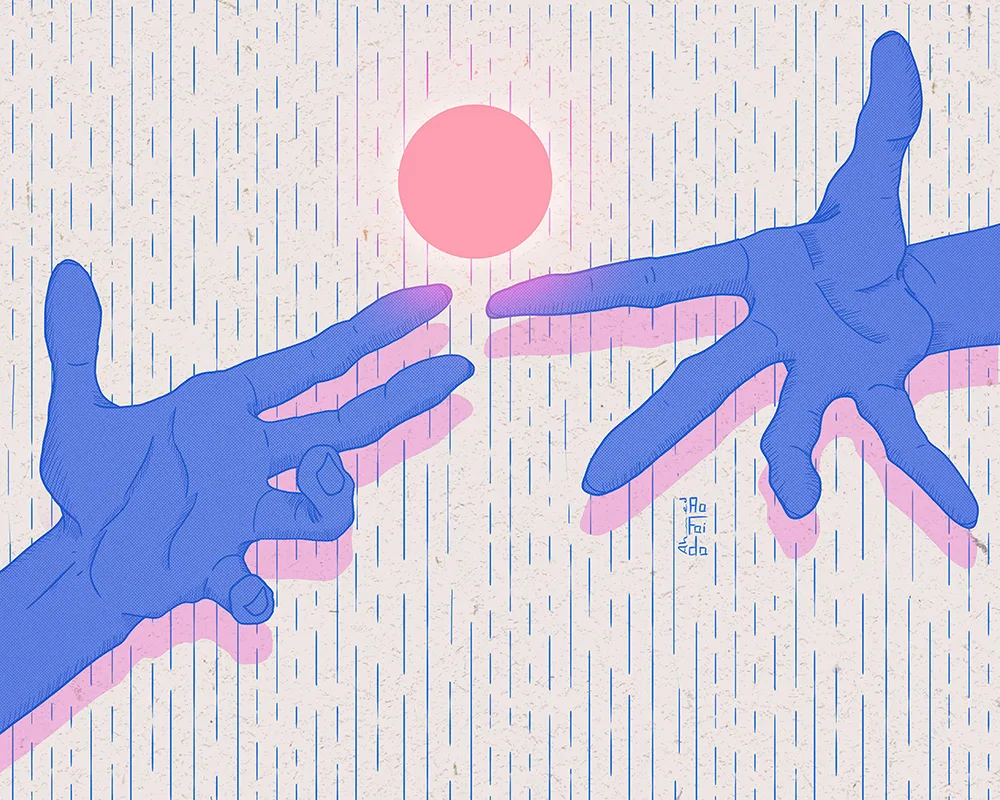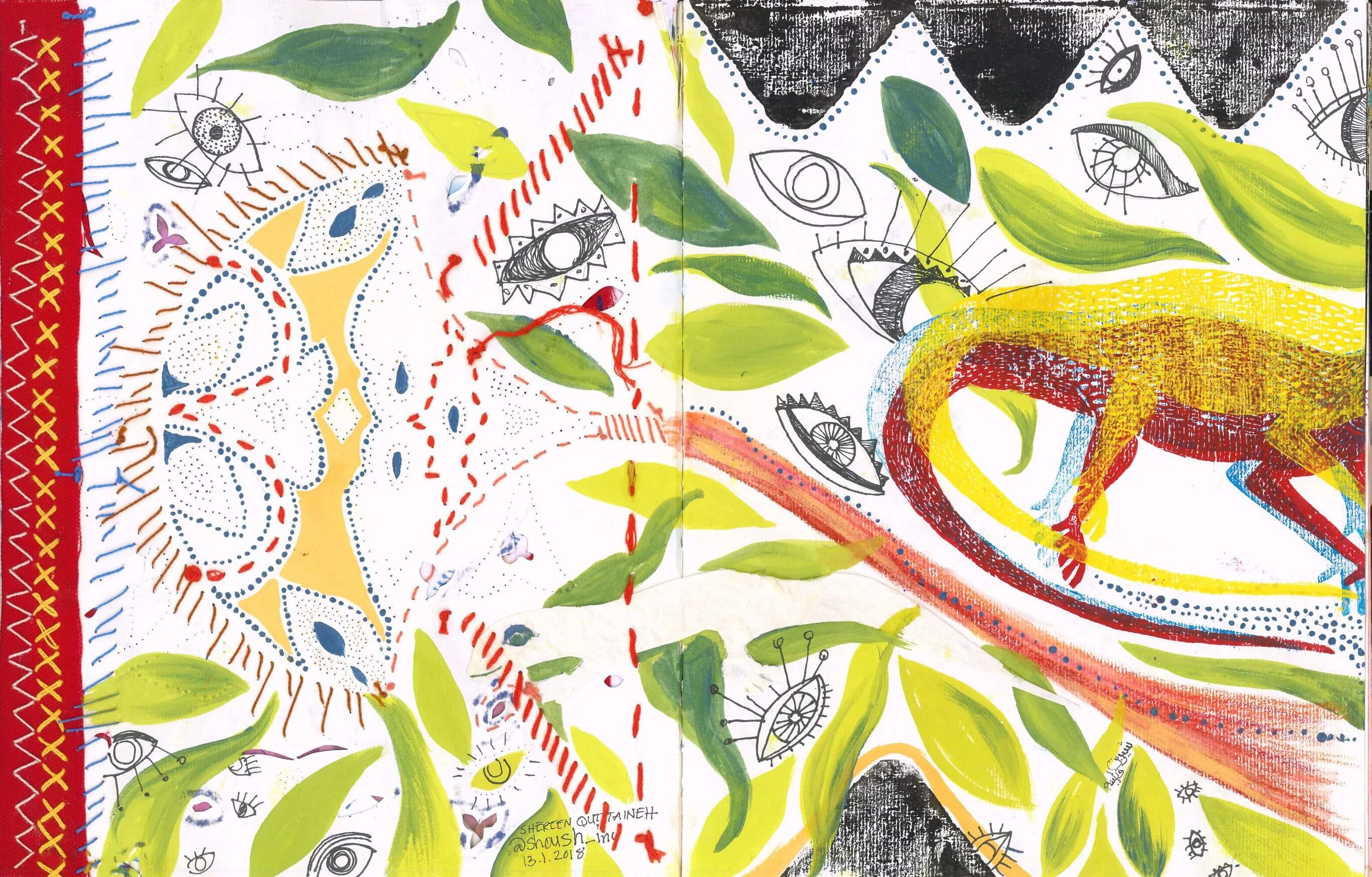

Daftar Asfar is the collection of sketchbooks travelling the world and encouraging hundreds of artists to create and collaborate. The artists involved, from street artists to ceramicists, are hand-picked. The books are only ever passed on by hand, and they’ve never been held by anyone who hasn’t added to them in some way. Allyssia Alleyne talks to the founders and some of the contributors who have filled their pages.
Sarah Ahmed, founder and editor of the Middle Eastern culture magazine Jaffat El Aqlam, remembers the first time she opened the inaugural Daftar Asfar. Having driven from her home in Abu Dhabi to pick it up from its custodian in Dubai, she was struck by the sketchbook’s hand-stitched binding, the thickness of the paper, and the intensity of its turmeric-yellow pages. “I remember flipping through it in the parking lot, and I couldn’t help but smile,” she says. “It felt precious… I was worried I’d accidentally tear a page, remove a thread, or drop it.”

Sarah is one of more than 120 creatives to lend their talents to Daftar Asfar (Arabic for “yellow sketchbook”), a publishing project based in the Middle East. Since 2017, the collective behind it has been circulating sketchbooks across the region and beyond, inviting selected participants in Jordan, the United Arab Emirates, London and New Mexico to leave their mark in an international game of Exquisite Corpse .
But among its contributors, Daftar Asfar is more than just a game or a set of artworks; It’s a valuable site for connection and creative expression. “Being part of something so human that forces a collaboration with a stranger and has unexpected results felt exciting,” says Sarah, who used her pages to map a narrative about the moon in watercolors and colored pencils. “In a way, they’ve created a community… I’m sure a lot of the participants followed each other and got to know people that may not have been in their immediate circle.”

Any inspiration that pushes someone to create something or discover an idea, to me, is a beautiful thing.

Daftar Asfar is the brainchild of the self-styled “Daftar Rangers,” artists Lena Kassicieh and Nahla Tabbaa, who are based in Dubai, and Sarah Hatahet, who lives in Abu Dhabi. Inspired by the Brooklyn Art Library’s Sketchbook Project, a collection of more than 50,000 sketchbooks donated by artists from around the world, they set out to create something with a similar spirit for the Middle East.
They settled on the idea of a collaborative project that would turn the usually solitary endeavour of sketchbooking into an opportunity to connect with the creatives in their circle and periphery. A handbound yellow sketchbook (a gift from Emarati artist Nasir Nasrallah) gave the project a home and a name. “The idea is to create this sense of community, and a collaborative work that’s exciting and playful,” says Lena. “An artist in New Mexico is no different from an artist in Dubai, even if they’ve never met or have completely different backgrounds, and I think that’s a really important thing people might take away from it.”

The result is a set of volumes (the original has spawned five more editions, including a Digital Daftar and a New Mexico Daftar) where calligraphy, textiles and clip art merge with watercolors, collages and all shades of illustration. The figurative gives way to abstraction, humor to spirituality, and minimalism to chaos. “It’s beautiful seeing such diversity in one place,” says Amman-based textile and embroidery artist Shereen Quttaineh, who contributed to the first sketchbook in January 2018. “Flipping through the pages of Daftar Asfar and seeing each artist’s work the creative, meaningful ways in which they intersect makes it very special,” she says. For Shereen, Daftar Asfar was a departure from her typically silent and “somewhat meditative practice.” Working with others proved eye-opening. “I had never collaborated on an artwork with anyone before, I must say the experience broke down a lot of boundaries for me,” she adds. “After taking part, the whole concept of play in art became part of my practice.”
“I felt the itch of the challenge!” says artist and contributor Zeina Saket, who is also based in Amman. While she enjoyed merging “the soft layered transparencies and cool colors that represent my style” with the striking red strokes left behind by her predecessor, Rand Abdulnour, she was equally excited by the question of what happens next, and how her work will “transform” in the hands of the next artist. Sarah, the editor in Abu Dhabi, felt the same sense of anticipation after finishing her contribution to Daftar Afsar: “It's designed in a way that leaves you wanting more,” she says. “It was a beautiful experience from beginning to end.”

It’s beautiful seeing such diversity in one place.

While they have final say on who contributes to the sketchbooks and when, the Rangers don’t assert ownership over Daftar Asfar. “By definition, a ranger is someone who takes care of a public property,” Nahla explains. “You're protecting something that is so much larger than you.” But if the sketchbooks are public property, access to them is restricted. They are never shipped, only hand-delivered by or picked-up from one of the Rangers, which limits their reach; and the one time the sketchbooks were exhibited together, at the 2019 edition of Art Dubai, they were all kept closed, unless one of the Rangers was turning the pages with gloved hands to reveal their secrets.
“The only people who have had the privilege of touching the pages of this book are the artists who have participated, who are handed the book for that fleeting moment, so that gives it magic and value,” Sarah, the Daftar Asfar co-founder, says. “I still get goosebumps whenever I touch it.”

In the future, the Rangers would like to do more to bring their mission to non-artist communities, too. “I would love for us to one day… have a physical space, and to regularly host workshops and teach things and encourage creativity in thought and spirit, not just through one project, but through an entire pedagogical practice and approach to living and to creating,” Lena says.
In the meantime, the curious will have to settle for perusing the Daftar Asfar archive on their website or on Instagram. “I hope it’s intriguing enough that might think about a different perspective, or that it encourages them to create things,” Lena says. “To me, any inspiration that pushes someone to create something or discover an idea is a beautiful thing.”


